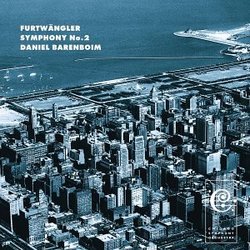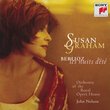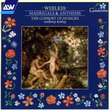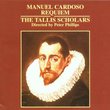| All Artists: Wilhelm Furtwangler, Daniel Barenboim, Chicago Symphony Orchestra Title: Furtwangler: Symphony No. 2 Members Wishing: 0 Total Copies: 0 Label: Teldec Release Date: 7/9/2002 Genre: Classical Style: Symphonies Number of Discs: 2 SwapaCD Credits: 2 UPC: 809274349521 |
Search - Wilhelm Furtwangler, Daniel Barenboim, Chicago Symphony Orchestra :: Furtwangler: Symphony No. 2
 | Wilhelm Furtwangler, Daniel Barenboim, Chicago Symphony Orchestra Furtwangler: Symphony No. 2 Genre: Classical
Wilhelm Furtwängler is best known as a conductor; he saw himself, however, as a composer who conducted. His first symphony is somewhat of a bore, and while the second, composed in 1944-45, does not break any new com... more » |
Larger Image |
CD DetailsSynopsis
Amazon.com Wilhelm Furtwängler is best known as a conductor; he saw himself, however, as a composer who conducted. His first symphony is somewhat of a bore, and while the second, composed in 1944-45, does not break any new compositional ground, it still fascinates. At 82 minutes, it's seen as a long last gasp of German Romanticism (Bruckner comes to mind). The third movement, probably the most entertaining, has Russian and Finnish (Sibelian) overtones, and the wind writing, over and under the swirling strings, is distinguished. In fact, Furtwängler proves himself to be a wise orchestrator--note the prominent bassoons in the first movement, the bass clarinet near the close of the third, and the near-epic brass chorales in the last. This recording, led by the Furtwängler-like Barenboim and gloriously played by the Chicago Symphony Orchestra, replaces the scrappy Marco Polo release and certainly sonically outclasses the composer's own performance on Orfeo, but the leisurely tempi employed by Barenboim (seven minutes slower than on Marco Polo and two minutes slower than the composer's) mean that it requires two CDs rather than one. Not a masterpiece, but a masterly performance of a work that deserves to be heard more often. --Robert Levine Similarly Requested CDs
|
CD ReviewsBarenboim's Labor of Love Thomas F. Bertonneau | Oswego, NY United States | 10/29/2002 (5 out of 5 stars) "Wilhelm Furtwangler thought of himself as a composer first and only then as a conductor of orchestras: posterity knows him -- who in fact disdained the recording studio -- as one of the stellar interpreters of the symphonic and operatic repertory of the twentieth century, thanks to the fact that so many of his concerts were recorded, beginning in the earliest part of the 1940s. Furtwangler did not compose prolifically, but his final tally of works is respectable. It includes three symphonies of Brucknerian proportions, a similarly vast Symphonic Concerto for Piano and Orchestra, some shorter orchestral compositions, a choral Te Deum, and four or five chamber scores. Of the symphonies, the best known is the Second (1945) in E Minor; with the Symphonic Concerto, the E Minor Symphony has gained tenuous currency over the years and has enjoyed a number of recordings (including off-air or concert recordings). Furtwangler himself was its original interpreter and he made a commercial registration for Deutsche Gramophon in 1952, with the Berlin Philharmonic, since reissued. At least two air-checks of Furtwangler performing this symphony also exist (one from Vienna and one from Stuttgart). A lion where it concerned leading Beethoven or Brahms, Furtwangler approached his own work with some diffidence. He said famously regarding the premiere of the Second Symphony that he felt as a young girl might if asked to shed her clothes in front of a lecherous old man ' conspicuously not the attitude of a creative artist supremely confident of his own talent. In the studio recording, especially, of the Second Symphony one hears this hesitancy, this authentic shyness. There is a slight but noticeable awkwardness in the phrasing which the listener might mistakenly attribute to the score itself had not one or two others found greater plasticity in the same grand paragraphs. Along comes what must now be granted the title of the definitive recorded version of Furtwangler's Second, with an orchestra that, briefly in 1948, Furtwangler hoped to make his own, the Chicago Symphony. The interpreter, Daniel Barenboim, met Furtwangler and received his blessing in 1954, when the former was an eleven-year-old piano prodigy and the latter was an Old Man of the Arts only a few months from his death. 'Genius,' Furtwangler proclaimed. Barenboim has understood himself (why not?) as a spiritual heir of the master since he was in his twenties, performing the keyboard part in the Symphonic Concerto, applying a Furtwanglerian style in his interpretations of Wagner and Bruckner, and now breathing new life into the E Minor Symphony. What about the Symphony itself? It comprises the standard four movements, the outer movements both being on a large scale while the two inner movements, a scherzo and an adagio, are more or less conventional in their proportions. As in the case of the Bruckner symphonies, none of the movements, even the Scherzo, uses truly rapid tempi. In the opening movement, Assai Moderato, Barenboim does not hesitate, as Furtwangler himself does, in setting things in motion. Barenboim endows the music with inevitability and under his direction it acquires a surety that Furtwangler's own interpretation (perhaps modestly) does not quite have. (Sample Barenboim's handling of the first great climax at about 5.30 into the movement.) A reviewer of another, mid-1990s, recording of the Second Symphony once accused it of having negligible melodic value, a charge that Barenboim's confident reading strongly refutes. The primary motives have always been immediately recallable, a point that Barenboim underlines. The Andante Semplice, begins with a woodwind theme that might have migrated from a Mozart serenade; a wonderful tenderness marks the melodic matter of the movement, which derives from the falling cadences of the first subject of the Assai Moderato. The mood becomes clouded. Barenboim understands the drama of it perfectly. He likewise grasps the moodiness of the Scherzo. At a half-an-hour, the Finale (Langsam -- Allmaehlich Vorwaerts -- Allegro Molto) is the most difficult of the Symphony's four panels to 'bring off.' Again, Barenboim makes it sound inevitable. I hope that nearly sixty years after the premiere of Furtwangler's Second Symphony, we have gotten over the collective delusion that twentieth century works need to sound like Stravinsky, or Schoenberg, or Webern, to be 'authentic.' The E-Minor Symphony is a work of deep emotional content and it might well be that it has awaited its due in Barenboim's dedicated comprehension of its plan. Buy this before it disappears." Furtwangler the composer played by a major orchestra !! Laurence Levine | FLUSHING, N.Y. USA | 10/23/2002 (4 out of 5 stars) "Daniel Barenboim, a great admirer of Furtwangler (he played Furtwangler's piano concerto under Zubin Mehta on a private label) recorded Furtwangler's second symphony. This work, perhaps his greatest composition requires much concentration and many listenings to yield its mysteries. The work opens with a tragic and mysterious first movement of enormous dimensions. A relatively short slow movement follows functioning like an intermezzo and leading to a vigorous scherzo. The opening movement's conflict is resolved in the great finale. When the motto theme is played at the coda (here Barenboim's cannot compare to the composer's performance) one is in tears. This is one of the greatest symphonies written. It has to be heard to be believed.The recording is top notch. The performance, while naturally failing to match Furtwangler's own interpretation is both masterful and eloquent. The Chicago Symphony plays its collective heart out. Thirty years ago, when I discovered Furtwangler the composer, I dreamt of recordings by major artists of his greatest works. At long last, here is the first installment. On to the piano concerto, which should be next. Thank you Mr. Barenboim." Interesting Piece, Great Performance. Laurence Levine | 02/08/2003 (5 out of 5 stars) "Until this important recording was released, it's likely that very few people, including myself, realized Furtwangler was a talented composer. Though maybe not quite in the compositional league of Bruckner or Mahler, Furtwangler clearly had a lot to offer with his interestingly creative melodies, rhythmic motives, and harmonic textures (listen to the third movement!).To be sure, the nuances and sonic impact of his second symphony are conveyed to full effect in this remarkable performance by the Chicago Symphony. The brass section of this orchestra usually receives the highest praise, and they certainly deserve it here. But the string playing is really something. Their burnished tone and eloquent phrasing adds enormously to the quieter and reflective moments of the piece. The winds also play with a great deal of skill and confidence, particularly in the exposed solo sections.Barenboim deserves credit for leading this terrific performance, as well as taking the initiative to perform and record this virtually unknown work. With Teldec's recording quality, the orchestra is presented in a clear, full sound."
|

 Track Listings (3) - Disc #1
Track Listings (3) - Disc #1



